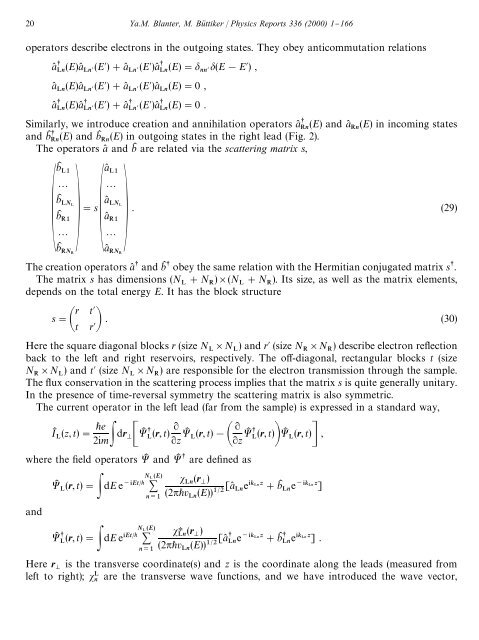shot noise in mesoscopic conductors - Low Temperature Laboratory
shot noise in mesoscopic conductors - Low Temperature Laboratory
shot noise in mesoscopic conductors - Low Temperature Laboratory
You also want an ePaper? Increase the reach of your titles
YUMPU automatically turns print PDFs into web optimized ePapers that Google loves.
20 Ya.M. Blanter, M. Bu( ttiker / Physics Reports 336 (2000) 1}166<br />
operators describe electrons <strong>in</strong> the outgo<strong>in</strong>g states. They obey anticommutation relations<br />
a( (E)a( (E)#a( (E)a( (E)" (E!E) ,<br />
a( (E)a( (E)#a( (E)a( (E)"0 ,<br />
a( (E)a( (E)#a( (E)a( (E)"0 .<br />
Similarly, we <strong>in</strong>troduce creation and annihilation operators a( (E) and a( (E) <strong>in</strong> <strong>in</strong>com<strong>in</strong>g states<br />
and bK (E) and bK (E) <strong>in</strong> outgo<strong>in</strong>g states <strong>in</strong> the right lead (Fig. 2).<br />
The operators a( and bK are related via the scatter<strong>in</strong>g matrix s,<br />
bK<br />
<br />
2 2<br />
bK a(<br />
. (29)<br />
bK a(<br />
<br />
2 2<br />
bK a(<br />
"sa(<br />
<br />
The creation operators a( and bK obey the same relation with the Hermitian conjugated matrix s.<br />
The matrix s has dimensions (N #N )(N #N ). Its size, as well as the matrix elements,<br />
<br />
depends on the total energy E. It has the block structure<br />
r t<br />
s" . (30)<br />
t r<br />
Here the square diagonal blocks r (size N N ) and r (size N N ) describe electron re#ection<br />
<br />
back to the left and right reservoirs, respectively. The o!-diagonal, rectangular blocks t (size<br />
N N ) and t (size N N ) are responsible for the electron transmission through the sample.<br />
<br />
The #ux conservation <strong>in</strong> the scatter<strong>in</strong>g process implies that the matrix s is quite generally unitary.<br />
In the presence of time-reversal symmetry the scatter<strong>in</strong>g matrix is also symmetric.<br />
The current operator <strong>in</strong> the left lead (far from the sample) is expressed <strong>in</strong> a standard way,<br />
IK (z, t)"<br />
e<br />
2im dr K (r, t)<br />
R<br />
Rz K (r, t)! R<br />
Rz K (r, t) K (r, t) ,<br />
<br />
where the "eld operators K and K are de"ned as<br />
and<br />
K (r, t)" dE e<br />
<br />
<br />
K (r, t)" dE e<br />
<br />
<br />
(r )<br />
(2v (E)) [a( e#bK e]<br />
H (r )<br />
(2v (E)) [a( e#bK e] .<br />
Here r is the transverse coord<strong>in</strong>ate(s) and z is the coord<strong>in</strong>ate along the leads (measured from<br />
left to right); are the transverse wave functions, and we have <strong>in</strong>troduced the wave vector,
















